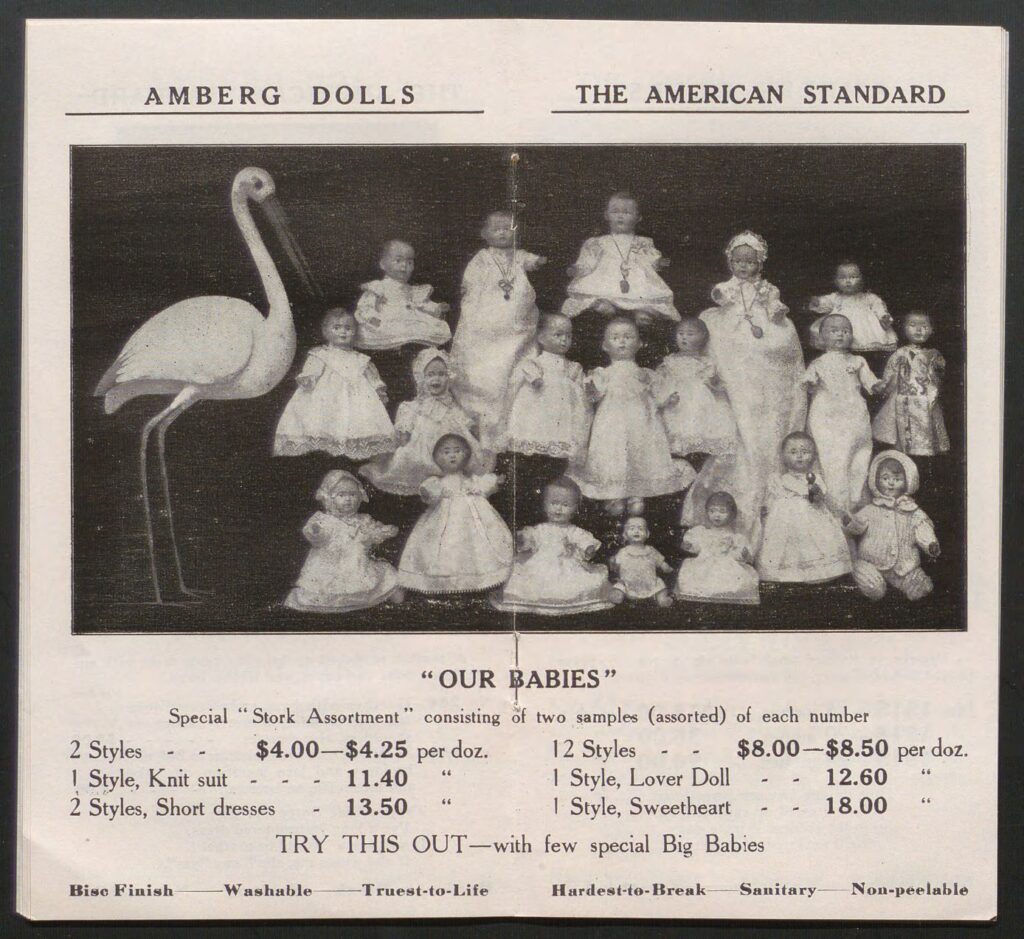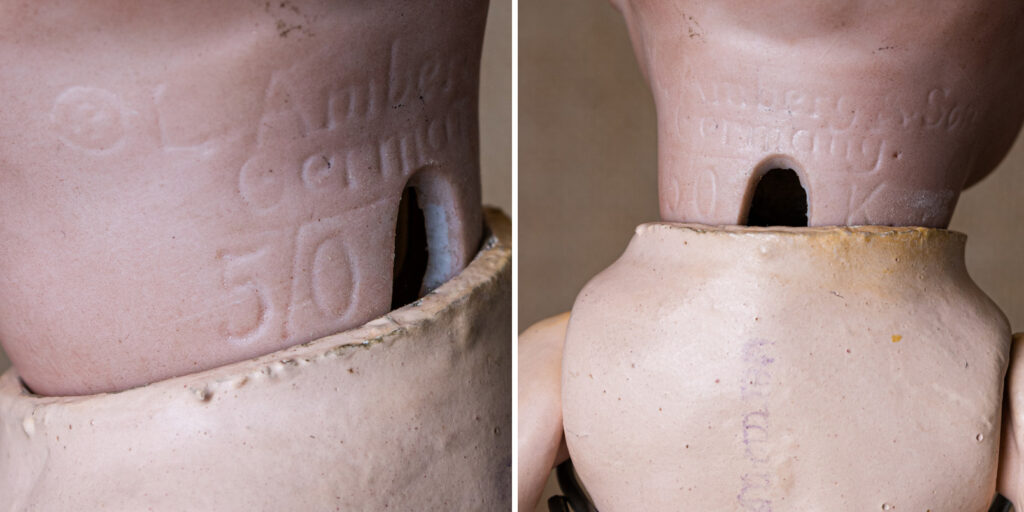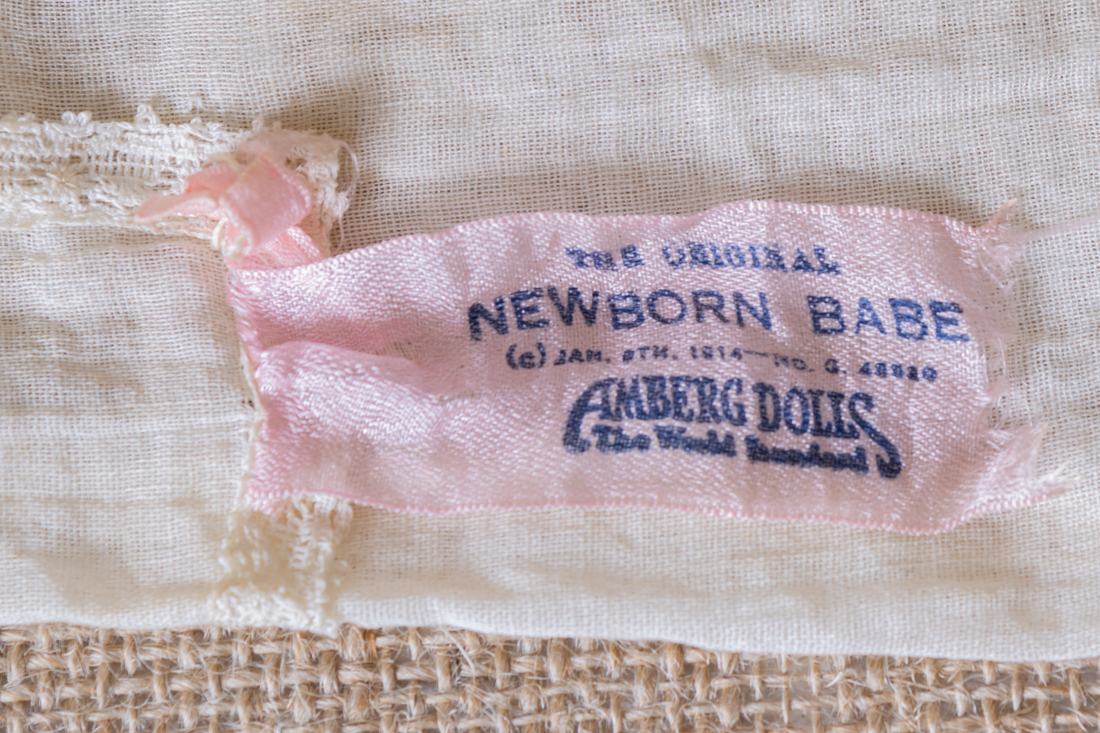Louis Amberg, born in Cincinatti in February of 1854, began business in Cincinnatti under the name of “Louis Amberg & Co.” In 1898 he moved to New York where his firm took on the name “Louis Amberg, Brill & Co.” until 1907. Then it changed to “Louis Amberg & Son.” His son, Joseph L. continued in the business after the death of his father. Louis Amberg died May 13 of erysipelas. (1915. Crockery and Glass Journal v. 81. p. 20).
De Witt C. Baker of Texas, joined Amberg Brill & Co. about 1898 after having worked with people like George Borgfeldt and E. I. Horsman. He worked with Amberg for two years.
One can find “Louis Amberg, Brill & Co.” mentioned as “notion dealers” occupyig the bottom floor of a building at Nos. 628 and 630 Broadway, New York and Nos. 118 and 120 Crosby St.
This Louis Amberg should not be mistaken for the mobster, Louis Amberg.
Leading Roles of Louis Amberg in the Toy Industry
In 1916 Louis Amberg served at that time as president of the American Doll Manufacturers Association. Americans now exported dolls all over the world. A newspaper article at that time called Louis Amberg, one of the biggest doll manufacturers of the time.
In February 1925 he chaired the reception committee for the Second Annual Washington Birthday Banquet of the Toy Fair Chamber of Commerce held at the Grand Ballroom of the Hotel Astor in New York where Col. Theodore Roosevelt gave a speech. Wm. Schoenhut was in attendance. (Playthings Magazine, February 1925). Amberg also served for a while as one of the directors of the Toy Fair Chamber of Commerce.
1910 Catalog of Dolls

One can view and turn the pages of a Louis Amber doll catalog from 1910 online at the Hagley Digital Archives here. The dolls in this catalog include:
- Wonder Baby wearing a drop lace trimmed dress and bonnet accented with rosettes and bows. The doll ranged from 15 inches to 20 inches.
- Baby Sister wearing a lawn dress standing 14 inches high.
- Baby Brother also 14 inches high.
- Baby Show Prize Winner also wearing a drop lace trimmed dress and bonnet and 14 inches tall.
- Lover Doll at 31 or 36 inches in long lace trimmed dress with insertions and ruffles.
- Undressed Doll ranging from 14 to 24 inches holding a celluloid rattle
- Blue Ribbon Baby at 14 and 24 inches
- Bright Eyes at 14 inches in a lace trimmed lawn dress with a bell rattle on a ribbon.
- Dotty Darling at 23 inches wearing a long dress with an embroidered yoke and capes, and ribbon bows.
- Sweetheart at 15 to 24 inches wearing knitted wool
- Curly Locks at 15 inches with molded hair
- Johnny Jones, a Kathe Kruse model, in a Buster Brown suit at 15 inches
- Miss Flirt at 15 inches with moldable hair and detachable ribbons in her hair
- Hail Columbia and Yankee Doodle, the neice and nephew of Uncle Sam, at 15 inches
- Dorothy Deere at 15 inches wearing a white shoulder strap dress
- Texas Tommies, boy and girl, at 12 or 15 inches
- and more
The Doll Strike of 1920 in New York
The doll industry in New York experienced a strike of workers who demanded a 35 percent increase in wages and a “shop chairman.” The strike ended the evening of May 13, 1920. Amberg explained that if the demands of the strikers or unions had been meant, the ownership of the doll manufacturing plants would have passed from the hands of the owners to the unions. Because German dolls once again came into America in great mass the competition was high. Amberg explained that if the unions had taken over the doll plants, it would have cripped American trade in the doll industry.
Effanbee Factory
The strike was waged mainly by the Italians working for Fleischaker & Baum according to Amberg. Amberg boasted his factory did not suffer from strike due to better management. He contributed part of the management practices of hiring several different nationalities to cause them. He claimed that the varied ideas and differing traditions meant they were less likely to organize forces.
Louis Amberg Factory
When a strike began at the Amberg factory it ended within one day. A squad of 50 Amberg police present on the premises contributed to it. Amberg promised to discharge one worker who came to him making demands.
Wages During the Time
In his interview with Toys and Novelties magazine, Amberg gave some statistics regarding doll factory workers’ wages at the current time. Body operators made $45 a week. Stuffers made $30 to $50 a week. Doll Dressers made $16 to $25 dolls a week. Painters made anywhere from $40 to $80 a week. Polishers could make about $35 to $90 a week. In comparison at that time a mail carrier in New York would make about $1200 to $1400 a year. School teachers made about $75 a month in New York City which after fighting for more had raises up to $125.
Louis Amberg Patent Question
The US Patent 1269056 registered June 11, 1918 has been contributed to Louis Amberg, but this patent belonged to inventor Frank Criest according the United States Patent and Trademark Office.
German Made “Newborn Babe” Doll
Even though Louis Amberg is known as an American doll manufacturer and importer, one of the famous Amberg dolls was made in Germany. The back of the bisque head reads “© L. Amberg & Son Germany 5/0 K” with an upside down U shape just before the K which is cut out in some of the doll heads. The back of the composition jointed body has “GERMANY” stamped on its back. Head mold resembles some heads manufactured by Armand Marseille so the doll may have been made in Sonneberg at the Marseille’s factories.
The doll’s dress has a tag that reads, “The Original NEWBORN BABE (c) Jan 9th 1914 Reg. g 48820 (or 45520) AMBERG DOLLS The World Standard.” Most likely manufactured before the start of World War I.
Amberg threatened publicly prosecute to the full extent of the law anyone who STATED or even INSINUATED that the Newborn Babe copied any doll. Many collectors today would say it looks a lot like Grace Putnam’s Bye-lo Baby.

Types of Amberg Dolls
In 1913 the Amberg line had 18 different dolls that sold for a dollar to shop owners but retailed up to $5 each. That year they were working on a “Baby Wonder Doll” that would retail up to $15. The 1913 July issue of Toys and Novelties provides an image of this Baby Wonder. Amberg claimed its dolls had a “bisc finish” or paint that gave the look of traditional bisque.
The company boasted have a doll that would not cause ill health to a child that usually might gnaw or lick its toys. This reflected the common knowledge that the German toys often had poisonous paints.
The September 1913 issue of Toys and Novelties shares an image of the Amberg “Tiny Tots: Kutest of the Kiddies.” The company planned the Tiny Tots to debut in 1914.
Louis Amberg manufactured various types of dolls. One can find ads referring to “Amberg Victory Dolls,” “Amberg Walking Dolls,” “Amberg Educational Dolls” and “Regal Sleepers.” They had names like Newborn Babe, AMKID, HAPPIFAT (Kate Jordan’s Chubby Youngsters). Some dolls advertised in 1913 had names like Yankee Doodle, Hail Columbia, Uncle Wiggly, and Miss Broadway. One in 1919 was named “Dotty Darling.”
The victory doll advertised in 1920 had a German made fully jointed body. The AMKID doll had a leather covered “kidette” torso and thighs with composition jointed arms and lower legs. One can find AMKID dolls with bisque heads manufactured by Armand Marseille.
In 1920 they advertised an address of Dept. 101 East 16th St. New York City.
At the Chicago Toy Fair of April 1920 Amberg Dolls exhibited in rooms 435-6 of the Morrison Hotel with Leo Strauss, Nathan Redlich Jr., and Herman Shapiro as representatives.

1927 Ad
The 1927 edition of “Playthings” carried a full page ad by Louis Amberg & Sons. The ad emphasized the phrase “Amberg Import Specialties.” He exported dolls from Sonneberg, Germany, with one ad showing Joe Amberg standing on a map of Sonneberg holding dolls in his arms. The ad from February 1927 read “Here’s the Latest! TOYS ACROSS THE SEA! Scores of exclusive new lilnes marvelous specialties outstanding values. It gives the Amberg trademark and the Broadway address.
In the magazine Louis Amberg & Son have an address listed at 869 Broadway with their listing just below the famous Alexander Doll Coll and nearby the Arranbee Doll Co. The listings represented exhibitors for the New York Toy Fair.
On page 51 of the issue another full page ad shows off a fully jointed “Mama Doll” by Louis Amberg & Son. The company gave the full line of Mama Dolls the name “Faerie Princess” which consisted of six sizes and given the slogan “The Aristocrat of the Nursery.”
Another Amberg doll advertised in the 1927 Playthings was the Vanta Baby.
See some other antique German doll manufacturer marks here.
See some antique French doll marks here
